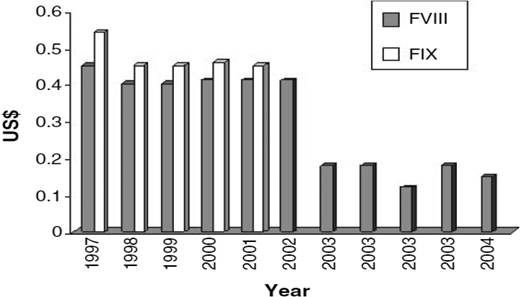Background
Inherited bleeding disorders (IBDs) are a heterogeneous group of rare diseases characterized by bleeding manifestations of variable severity. IBDs require life-saving treatment, which is complex and costly. Treatment usually requires intravenous infusion of clotting factor concentrates (CFCs) and/or blood products on a prophylactic and/or episodic basis.
The aim of this presentation is to describe the processes and outcomes of the National Program of Inherited Bleeding Disorders of the Ministry of Health (MOH) since 2004 in Brazil.
The beginning
The population of patients with IBDs increased nearly 200% from 2002 to 2018 (Figure 1). This was a result of policies that focused on educating personnel who worked in the hemophilia treatment centers (HTCs) and diagnostic laboratories, on producing guidance documents, and on teaching the principles of treating patients. Brazil now has the fourth largest population of patients with hemophilia in the world.1
Evolution of the population of patients with IBDs in Brazil, 2002-2018 (from Perfil das coagulopatias hereditárias no Brasil, 2018 [unpublished]).
Evolution of the population of patients with IBDs in Brazil, 2002-2018 (from Perfil das coagulopatias hereditárias no Brasil, 2018 [unpublished]).
Registry of IBDs
In 2009, we built a Web-based registry that collects clinical, laboratory, and treatment data on all patients with IBDs in Brazil2 (Figure 2).
Treatment
To treat these patients, policies were instituted and consisted of changes in the process of purchasing CFCs, resulting in more competitive prices,3 and distribution of CFCs to the HTCs (Figures 3 and 4). This enabled the purchase of larger quantities of CFCs and implementation of home therapy, hemophilia prophylaxis, immune tolerance induction (ITI) for hemophilia A from 2012 onward, and treatment of all rare IBDs.
Evolution of the use of FVIII and FIX concentrates in Brazil, 2005-2018 (unpublished).
Evolution of the use of FVIII and FIX concentrates in Brazil, 2005-2018 (unpublished).
Outcomes
The implementation of several policies in the IBD program has improved health outcomes and has decreased mortality4 (Figure 5) and reduced the prevalence of inhibitors and hemophilic arthropathy. Currently, about 400 patients with hemophilia A are included in ITIs with a success rate of 74%.5
Standardized mortality ratios for males with hemophilia A and hemophilia B, 2000-2014.5
Standardized mortality ratios for males with hemophilia A and hemophilia B, 2000-2014.5
Acknowledgments
The authors thank the professional team of the MOH involved with the National Program of Inherited Bleeding Disorders, patients, their guardians, HTCs and their multiprofessional teams, the Brazilian Federation of Hemophilia and its associations, and the dedicated committees of MOH composed of medical doctors and laboratory professionals.
Authorship
Conflict-of-interest disclosure: J.P.B.A. is a member of the Board of Directors of Hemobras and its advisory committees. G.G. has served as a consultant for Biomarin, Roche, Shire, Octapharma, and Takeda and has received honoraria from Shire, Roche, and Octapharma. The remaining authors declare no competing financial interests.
Correspondence: Suely M. Rezende, Faculty of Medicine, Universidade Federal de Minas Gerais, Avenida Alfredo Balena 190, Room 255, Belo Horizonte, MG, Brazil 30130-100; e-mail: suely.rezende@uol.com.br or srezende@medicina.ufmg.br

![Evolution of the population of patients with IBDs in Brazil, 2002-2018 (from Perfil das coagulopatias hereditárias no Brasil, 2018 [unpublished]).](https://ash.silverchair-cdn.com/ash/content_public/journal/bloodadvances/3/supplement%201/10.1182_bloodadvances.2019gs121559/3/m_glo121559pof1.png?Expires=1769089524&Signature=2whpFXZQZsu72FnGlQ4pr6hOycLxFH4EaLS2wcaM7SxDR2jac89LyeGNJd6ez2ZEe4rkDC6ZgkYLe7kRFZdBnuByccTkTilnk9W6w1dpvUPOm2wVmQY3mqEZBU7qRG20gxENMynVGKyz3ydFHeloflqj2YdJhVjUSzLnTgxXeR42g68tpdt2uN42FPx4iRqt3ZyxMNuSH8RbFKAabQDJP62s86VOth01x4O~rHwwCGwjExz~1rTyMr1Ik1m~XIvimC2O~iw6sVLRYS0SIZmsypaoVl2AOPS-e3~-PvKS7Y72ISyLUVa9sgAJiBDVRfTUq23EbIEVW0GS9cr6~c5xqg__&Key-Pair-Id=APKAIE5G5CRDK6RD3PGA)



